WARNING: Some details of this story may be disturbing to some readers. Discretion is advised.
B.C.’s controversial wolf management program is under fire again with some troubling news from Alberta.
Shane Ramstead lives in the city of Spruce Grove, a bedroom community just west of Edmonton, and is a former fish and wildlife officer.
He told Global News that last winter he came upon almost-dead wolf near the community of Grande Cache, located northwest of Edmonton in Alberta’s foothills.
“I had first encountered the animal by some pictures off of our trail cameras,” Ramstead said.
“We use an extensive number of trail cameras just monitoring different wildlife or whatever. And near my cabin area, three of the cameras had picked up this lone wolf, which in itself is rare.
“There are so few wolves around.”
He said most of the wolves in the area were shot from helicopters or poisoned but this one was also moving over a small geographic area, which is strange behaviour.
“I had some significant experience with the use of radio collars from my past career as a fish and wildlife officer on grizzly bears and lots of experience of seeing them on caribou,” Ramstead added.
“And this one just looked not right, coincidentally.”
Read more:
Critics denounce use of military-grade rifles by province in B.C. wolf cull
Read next:
Part of the Sun breaks free and forms a strange vortex, baffling scientists
The next time he saw the wolf alive it was trying to eat a deer carcass at the side of a road.
“And I could tell then that its movements were restrictive — the way it moved its head, the way it was trying to feed or look up and down, it wouldn’t run,” he said. “So it was displaying very abnormal wolf behaviours.
“Then over the next couple of days, I used the snow machine and followed some tracks and found that where it had gone up, walking to the west, up the Berlin Valley, and could tell it was still not acting normal.”
Ramstead said he could tell the wolf was suffering so he decided to euthanize it. He did not say how he did that.
“That collar was so restrictive,” he said.
“Obviously put on at a younger age, and it had embedded itself down in through the skin and into the meat and was causing it discomfort.”
“It was just not having a good existence.”

Ramstead said the collar had a marking on it so he called the corresponding phone number.
He received a call back from a wildlife specialist in Fort St. John, B.C., located about 400 kilometres to the northwest, just across the provincial border.
The specialist told Ramstead he had collared that particular wolf himself.
Ramstead said this man confirmed he had done this as part of the province’s Wolf Cull program, which aims to protect the endangered caribou populations.
He then sent over the photos of the wolf and explained what happened to it.
Ramstead said it appears this wolf was a Judas Wolf, referring to a scenario when an Alpha male wolf is caught, fixed with a tracking device, and followed back to his pack.
Then helicopters are dispatched to kill the family unit from the air. Sadie Parr with Wolf Awareness, based in Golden B.C., explained this process to Global News last April.
The B.C. government has said in the past that the Wolf Cull Program is a humane way to control the population and increase the caribou population.
But wildlife organizations say this is not the case.

Bryce Casavant, director of conservation intelligence at Pacific Wild told Global News, “we do not believe that the wolf cull is a humane process, despite what the government says.”
He said he saw the photos from Ramstead and communication from the B.C. government with confirmation that this was a B.C. wolf.
“These pictures show that the process involved in this particular wolf cull and the collaring of wolves, especially Judas wolves, is likely not a humane process. It’s a direct counter to what the government is suggesting.”
Casavant said the public should not have to take the government’s word that this is a humane way of keeping the wolf population under control.
“This seems like an aggressive thing to say, but I’m fairly confident in saying the provincial staff involved in the wolf cull program are on the line, on the border of abusing and misinterpreting and mis-supplying our freedom of information laws,” he said.
Casavant added that Pacific Wild has been told they won’t ever get the photos in the provincial wolf cull database because they will make them publicly available.
“It’s graphic content. It defies logic. It defies logic of any kind of ethical behaviour when it comes to the part of provincial staff and it’s with a heavy heart and regret that it’s come to this point where instead of having these conversations academically and being able to have independent verifications and some sanitization of the information, unfortunately, the government has put our organization in a position where the only action left is to bring this information forward to the public in this manner.
“And this is the last act of transparency and that is what we’re calling for.”
Read more:
‘It’s shameful, it’s horrifying’: B.C. conservationists call for end to controversial wolf cull
Read next:
Exclusive: Widow’s 911 call before James Smith Cree Nation murders reveals prior violence
Global News reached out to the provincial government for comment but did not hear back by the time of publication.
Ramstead also said he remains disillusioned and dismayed with the efforts of Canadian governments to exploit wildlife.
“I witnessed significant death and slaughter at the hands of government very closely in my work career, ” he said.
“As a conservationist, I had hard times and struggles supporting any of this initiative when there were many other solutions that were available to government that weren’t being used.
“It’s a sad state of affairs when you can simply make some political decisions to forsake some logging in core caribou habitats, etc., versus wanton slaughter of wildlife to try to manage the whole ecosystem for all species and not just, in my opinion, one species management for caribou, which is what they’re doing here.”
“This wolf slaughter and how they operate with taxpayers’ money is, in my opinion, abhorrent.”
Ramstead said he would like to see breakaway collars used, at the very least, so that when a wolf grows too big it will come off and not leave the animal suffering.
© 2023 Global News, a division of Corus Entertainment Inc.
 Asian Tribune Your Multilingual Newspaper covering World and local news News
Asian Tribune Your Multilingual Newspaper covering World and local news News



